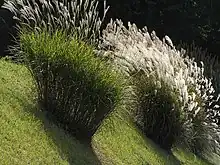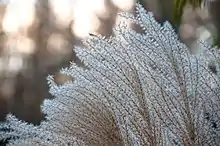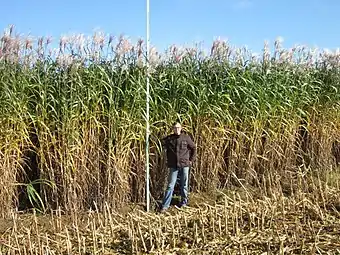Miscanthus
Miscanthus, or silvergrass,[4] is a genus of African, Eurasian, and Pacific Island plants in the grass family, Poaceae.[5][6]
- Miscanthus changii Y.N.Lee – Korea
- Miscanthus depauperatus Merr. – the Philippines
- Miscanthus ecklonii (Nees) Mabb. – southern Africa
- Miscanthus floridulus – China, Japan, Southeast Asia, Pacific Islands
- Miscanthus fuscus (Roxb.) Benth. – Indian Subcontinent, Indochina, Pen Malaysia
- Miscanthus junceus – southern Africa
- Miscanthus lutarioriparius L.Liu ex S.L.Chen & Renvoize – Hubei, Hunan
- Miscanthus nepalensis (Trin.) Hack. – Indian Subcontinent, Tibet, Yunnan, Myanmar, Vietnam, Pen Malaysia
- Miscanthus nudipes (Griseb.) Hack. – Assam, Bhutan, Nepal, Sikkim, Tibet, Yunnan
- Miscanthus × ogiformis Honda – Korea, Japan
- Miscanthus oligostachyus Stapf. – Korea, Japan
- Miscanthus paniculatus (B.S.Sun) S.L.Chen & Renvoize – Guizhou, Sichuan, Yunnan
- Miscanthus sacchariflorus – Korea, Japan, northeastern China, Russian Far East
- Miscanthus sinensis – Korea, Japan, China, Southeast Asia, Russian Far East; naturalized in New Zealand, North America, South America
- Miscanthus tinctorius (Steud.) Hack. – Japan
- Miscanthus villosus Y.C.Liu & H.Peng – Yunnan
- Miscanthus violaceus (K.Schum.) Pilg. – tropical Africa
- formerly included[3]
| Miscanthus | |
|---|---|
 | |
| Miscanthus sinensis | |
| Scientific classification | |
| Kingdom: | Plantae |
| Clade: | Tracheophytes |
| Clade: | Angiosperms |
| Clade: | Monocots |
| Clade: | Commelinids |
| Order: | Poales |
| Family: | Poaceae |
| Subfamily: | Panicoideae |
| Supertribe: | Andropogonodae |
| Tribe: | Andropogoneae |
| Subtribe: | Saccharinae |
| Genus: | Miscanthus Andersson |
| Type species | |
| Miscanthus capensis | |
| Synonyms[3] | |
| |
see Chloris, Pseudopogonatherum, Saccharum, and Spodiopogon
- Miscanthus affinis – Pseudopogonatherum quadrinerve
- Miscanthus cotulifer – Spodiopogon cotulifer
- Miscanthus polydactylos – Chloris elata
- Miscanthus rufipilus – Saccharum rufipilum
- Miscanthus tanakae – Pseudopogonatherum speciosum
Physiology
A wide variety in cold tolerance occurs in the genus. M. × giganteus is especially vulnerable to cold, and a cultivar of M. sinensis has the best known cold tolerance.[8]
Miscanthus sinensis

M. sinensis is widely cultivated as an ornamental plant, and is the source of several cultivars. In Japan, where it is known as susuki (すすき), it is considered an iconic plant of late summer and early autumn. It is mentioned in the Man'yōshū (VIII:1538) as one of the seven autumn flowers (aki no nana kusa, 秋の七草). It is used for the eighth month in hanafuda playing cards. It is decorated with bush clover for the Mid-Autumn Festival. Miscanthus has also excellent fiber properties for papermaking.
Miscanthus × giganteus

Miscanthus × giganteus (Miscanthus giganteus, giant miscanthus)[A 1] is a highly productive, rhizomatous C4 perennial grass, originating from Asia.[A 2] It is a sterile (noninvasive) hybrid of M. sinensis and M. sacchariflorus, and grows to heights of more than 4 m (13 ft) in one growing season (from the third season onwards). In temperate climates such as in Europe, the dry mass yield is 10–40 metric tons per hectare (4.5–17.8 short ton/acre) per year, depending on location.[A 3] Just like Pennisetum purpureum and Saccharum ravennae (which grow to the same height), it is also called "elephant grass".
Miscanthus' ability to grow on marginal land and in relatively cold weather conditions, its rapid CO2 absorption, its significant carbon sequestration, and its high yield make it a favorite choice as a biofuel.[9][10]
Miscanthus is mainly used for heat and power, but can also be used as input for ethanol production (if harvested wet). If harvested dry, it can be burnt directly in biomass boilers, or processed further (pellets, briquettes). It can also be used as a "green" building material, for both wall construction and as general insulation. An experimental house based on Miscanthus straw bales was built in 2017.[11] Miscanthus cropping enhances nutrient cycling in the plant–soil system.[12]
References
- lectotype designated by Coville, Contr. U.S. Natl. Herb. 9: 400 (8 Apr 1905)
- Tropicos, Miscanthus Andersson
- Kew World Checklist of Selected Plant Families
- USDA, NRCS (n.d.). "Miscanthus". The PLANTS Database (plants.usda.gov). Greensboro, North Carolina: National Plant Data Team. Retrieved 13 July 2015.
- Andersson, Nils Johan. 1855. Öfversigt af Förhandlingar: Kongl. Svenska Vetenskaps-Akademien 12: 165.
- Flora of China Vol. 22 Page 581 芒属 mang shu Miscanthus Andersson, Öfvers. Kongl. Vetensk.-Akad. Förh. 12: 165. 1855.
- The Plant List search for Miscanthus
- Carroll, Andrew; Somerville, Chris (2009-06-01). "Cellulosic Biofuels". Annual Review of Plant Biology. Annual Reviews. 60 (1): 165–182. doi:10.1146/annurev.arplant.043008.092125. ISSN 1543-5008. PMID 19014348.
- Lewandowski, Iris; Clifton-Brown, John; Trindade, Luisa M.; van der Linden, Gerard C.; Schwarz, Kai-Uwe; Müller-Sämann, Karl; Anisimov, Alexander; Chen, C.-L.; Dolstra, Oene; Donnison, Iain S.; Farrar, Kerrie; Fonteyne, Simon; Harding, Graham; Hastings, Astley; Huxley, Laurie M.; Iqbal, Yasir; Khokhlov, Nikolay; Kiesel, Andreas; Lootens, Peter; Meyer, Heike; Mos, Michal; Muylle, Hilde; Nunn, Chris; Özgüven, Mensure; Roldán-Ruiz, Isabel; Schüle, Heinrich; Tarakanov, Ivan; van der Weijde, Tim; Wagner, Moritz; Xi, Qingguo; Kalinina, Olena (2016-11-18). "Progress on Optimizing Miscanthus Biomass Production for the European Bioeconomy: Results of the EU FP7 Project OPTIMISC". Frontiers in Plant Science. Frontiers. 7: 1620. doi:10.3389/fpls.2016.01620. ISSN 1664-462X. PMC 5114296. PMID 27917177. p. 1620:
Field experiments with the only genotype currently commercially available, Miscanthus × giganteus, a clone-based interspecies hybrid, have revealed its great photosynthetic efficiency, high biomass yield capacity, low input demands, and good tolerance of temperate climates, and many of the characteristics that make miscanthus an ideal biomass crop.
- Yablonovitch, Eli; Deckman, Harry W. (2023-04-18). "Scalable, economical, and stable sequestration of agricultural fixed carbon". Proceedings of the National Academy of Sciences. 120 (16): e2217695120. Bibcode:2023PNAS..12017695Y. doi:10.1073/pnas.2217695120. ISSN 0027-8424. PMC 10120047. PMID 37040411.
- Blog of Centre for Alternative Technology in Wales: "The world’s first Miscanthus bale house". Retrieved 2017-11-27
- Willy H. Verheye, ed. (2010). "Perennial Energy Crops: Growth and Management". Soils, Plant Growth and Crop Production Volume III. EOLSS Publishers. p. 37. ISBN 978-1-84826-369-7.
- Anderson, Eric; Arundale, Rebecca; Maughan, Matthew; Oladeinde, Adebosola; Wycislo, Andrew; Voigt, Thomas (2011). "Growth and agronomy of Miscanthus × giganteus for biomass production". Biofuels. Taylor & Francis. 2 (1): 71–87. doi:10.4155/bfs.10.80. ISSN 1759-7269. S2CID 108696716.
- p. 71, "Recent classification work at the Royal Botanic Gardens at Kew, England has designated it as M. x giganteus […], a hybrid of M. sinensis […] and M. sacchariflorus […]"
- p. 71, "M. × giganteus is a highly productive, sterile, rhizomatous C4 perennial grass that was collected in Yokahama, Japan, in 1935 by Aksel Olsen. It was taken to Denmark, where it was cultivated and spread throughout Europe and into North America for planting in horticultural settings."
- p. 79, "The majority of the literature reporting dry biomass yield for M. × giganteus originates from European studies. Ceiling peak biomass yields in established stands of M. x giganteus have approached 40 t dry matter (DM) ha−1 in some European locations, although it may take 3–5 years to achieve these ceiling yields [84]. Across Europe, harvestable yields of up to 25 t DM ha-1 from established stands of M. × giganteus have been reported in areas between central Germany and southern Italy, while peak yields in central and northern Europe have ranged between 10–25 t DM ha-1, and in excess of 30 t DM ha-1 in southern Europe [3]. A quantitative review of established M. × giganteus stands across Europe reported a mean peak biomass yield of 22 t DM ha-1, averaged across N rates and precipitation levels [1]."
External links
- UK's National Centre for Biorenewable Energy, Fuels and Materials
- Miscanthus × giganteus - as an energy crop - Miscanthus Research at the University of Illinois